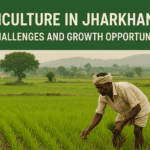Introduction
Have you ever wondered where the rice on your plate or the vegetables in your basket actually come from? Who grew them? Were they farmed using safe and ethical methods?
For decades, consumers had little visibility into the origins of their food. Farmers remained invisible, middlemen controlled the narrative, and consumers had no way to verify authenticity. This lack of trust created doubts about quality, safety, and fairness.
Enter traceability in agriculture—a system that allows every product to be tracked back to the farm and the farmer who produced it. Traceability is more than a buzzword; it’s about connecting people to the source of their food, building trust, and ensuring fairness across the agricultural ecosystem.
What is Traceability in Agriculture?
Traceability means being able to track food products through every stage of the supply chain—from cultivation to consumption. It answers key questions:
- Which farm did this crop come from?
- Who was the farmer behind it?
- What methods were used in production (organic, pesticide-free, hybrid)?
- How was it transported and stored?
- Was it handled ethically and hygienically?
In simple terms, traceability makes the food journey visible, verifiable, and trustworthy.
Why Knowing Your Farmer Matters
- Food Safety & Trust
Consumers can verify whether the food is chemical-free, organic, or grown with safe practices. This reduces fear of adulteration. - Fair Trade & Ethical Sourcing
When you know your farmer, you know they are getting a fair price for their hard work instead of being exploited by middlemen. - Stronger Emotional Connection
Buying food is no longer a cold transaction—it becomes a relationship. Consumers feel proud to support a specific farmer or community. - Cultural & Regional Identity
Traceability preserves regional food identities. Example: Chhattisgarh’s aromatic rice varieties or Odisha’s turmeric can be tagged to their origins, making them more valuable. - Empowerment of Farmers
Farmers gain visibility, recognition, and respect when their name is associated with the product. This motivates them to adopt better practices.
How Traceability Works in Practice
- Step 1: Data Collection – Farmers upload crop details (farm location, sowing date, harvest date, methods used).
- Step 2: Digital Tracking – Each batch is assigned a unique ID or QR code.
- Step 3: Logistics Transparency – Storage, transportation, and handling details are recorded.
- Step 4: Consumer Access – At the market or supermarket, consumers scan the code and instantly view the farmer’s profile, harvest details, and certifications.
Example: A shopper in Raipur scans a packet of lentils and learns:
- Grown by Ramesh Patel, Bilaspur
- Harvested on 15th September 2025
- Pesticide-free
- Stored in cold storage at 18°C
Key Benefits of Transparency for Every Stakeholder
Consumer Benefits
- Make healthier and safer food choices with verified information.
- Enjoy complete product traceability — from farm to fork.
- Gain trust through ethical and sustainable practices.
Farmer Advantages
- Get recognition for their identity and hard work in the supply chain.
- Achieve better negotiation power with wholesalers and buyers.
- Create stronger trust with consumers and businesses.
Business Benefits
- Strengthen brand loyalty and encourage repeat customers.
- Gain a competitive edge in today’s crowded marketplace.
- Ensure fraud prevention and protect your brand reputation.
Case Studies: Traceability in Action
1. Madhya Pradesh Soybean Farmers
By adopting QR code-based traceability, MP soybean farmers were able to sell directly to exporters. Buyers abroad were assured of non-GMO, pesticide-free produce, leading to higher export prices.
2. Chhattisgarh Rice Farmers
Rice varieties like Jeera Phool were traditionally undervalued. Thanks to traceability, farmers earn more with the “GI tag,” while consumers enjoy authentic regional rice.
3. Odisha Vegetables for Urban Markets
Farmers near Bhubaneswar supply vegetables directly to restaurants with traceability tags. Chefs love it because they can advertise dishes as “locally sourced from XYZ farmer,” building customer trust.
Technologies Enabling Traceability
- Blockchain – Ensures data is tamper-proof.
- QR Codes & RFID Tags – Quick consumer access to product history.
- Mobile Apps & Farmer Platforms – Farmers can upload details in simple steps.
- AI & IoT Sensors – Monitor soil health, harvest times, and storage conditions.
Platforms like Bharat Farm Connect are combining these technologies to create transparent food journeys.
Challenges in Implementing Traceability
- Cost of Implementation – Small farmers may find tech adoption expensive.
- Digital Illiteracy – Farmers need training to use apps and digital tools.
- Infrastructure Gaps – Poor logistics, storage, and internet connectivity in rural areas.
- Resistance from Middlemen – Those who profit from opacity often resist change.
But with rising consumer demand for safe and authentic food, the shift toward traceability is unstoppable.
Traditional System vs Traceability-Based Agriculture
| Aspect | Traditional System | Traceability System |
|---|---|---|
| Farmer Visibility | Hidden, unknown | Recognized, farmer name on product |
| Consumer Trust | Low, doubts about quality | High, verified origin & safety |
| Fair Pricing | Middlemen take big share | Farmers earn directly |
| Food Safety | Risk of adulteration | Transparent, certified |
| Market Scope | Local, limited | Wider, including exports |
How Bharat Farm Connect Promotes Traceability
- Farmer Profiles: Every farmer has a digital identity linked to products.
- Source Mapping: Each crop is traceable back to the village and field.
- Farmers receive fair payment, giving consumers confidence through Fair Trade Assurance.
- Consumer Education: Blogs and stories highlight real farmer journeys, not just products.
By making the supply chain transparent, Bharat Farm Connect ensures that consumers know, trust, and respect the farmers who feed them.
Conclusion
In the 21st century, consumers no longer want just food—they want the story behind their food. Traceability in agriculture bridges the gap between producers and consumers, ensuring safety, fairness, and trust.
Knowing your farmer is more than a marketing gimmick; it’s about building relationships, preserving heritage, and rewarding honesty.
With platforms like Bharat Farm Connect, traceability is becoming the new normal in India’s agricultural landscape—empowering farmers, satisfying consumers, and creating a sustainable, trustworthy food system.






